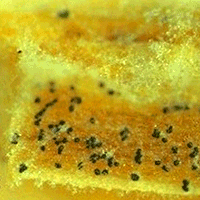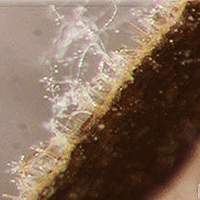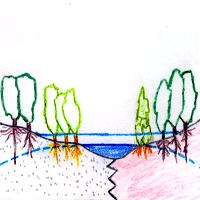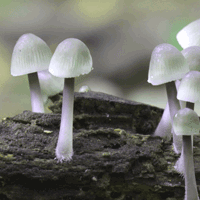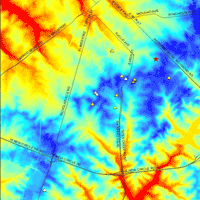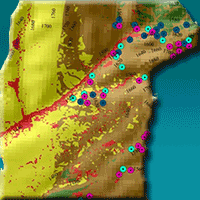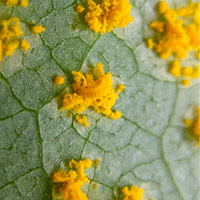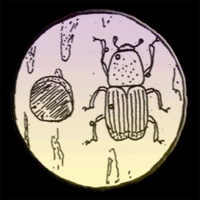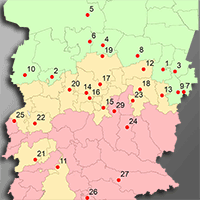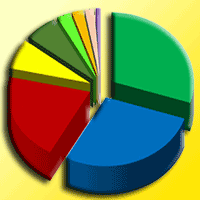Verticillium spp., including V. nonalfalfae and V. dahliae, are known vascular wilt pathogens of the invasive Ailanthus altissima (tree-of-heaven) in the United States and in Europe. Herein we provide evidence of the presence of a previously unreported wilt disease of A. altissima in Tuscany (Central Italy). Several isolates were collected from two locations and identified as V. dahliae, based on microscopical features of conidiophores, conidia and microsclerotia. Genomic DNA was extracted from the mycelium, the ITS region was amplified and the sequence was deposited in GenBank as VdGL16 (accession no. MK474459). BLASTn analysis showed 100% similarity with V. dahliae. To confirm pathogenicity of VdGL16, inoculations of Ailanthus seedlings were performed with the root dipping technique whereas mature trees were stem-inoculated. All inoculated seedlings exhibited wilt symptoms after 20 days, while mature Ailanthus trees showed wilting and dieback after six months. The pathogen was easily re-isolated from seedlings and re-identified as V. dahliae, thus satisfying Koch’s postulates. Results from intraspecific resistance screening of nine seed sources from across Italy revealed that Ailanthus provenances from all the six sampled regions were susceptible to V. dahliae. Stem inoculated adult plants exhibited abundant production of epicormic sprouts along the stem within six months, and most of these sprouts wilted following initial dieback of the main stem; furthermore, sprouting from the crown was intense. Petioles and rachises tissues of leaves fallen from infected trees were a good source for re-isolation of the pathogen; we proved that such petioles and rachises can effectively transfer the fungus to healthy Ailanthus seedlings via root infections. Host-specificity of the V. dahliae isolate VdGL16 was also determined on 40 non-target species/varieties/cultivars. The isolate caused disease in herbaceous species belonging to five botanical families: Asteraceae, Lamiaceae, Leguminoseae, Linaceae and Solanaceae. Given the difficulties in countering Ailanthus invasion with mechanical and chemical methods, the biological control using Verticillium may provide an efficient, low cost and sustainable control of this invasive species.
Keywords
, , , , ,
Citation
Pisuttu C, Marchica A, Bernardi R, Calzone A, Cotrozzi L, Nali C, Pellegrini E, Lorenzini G (2020). Verticillium wilt of Ailanthus altissima in Italy caused by V. dahliae: new outbreaks from Tuscany. iForest 13: 238-245. - doi: 10.3832/ifor3238-013
Academic Editor
Alberto Santini
Paper history
Received: Sep 13, 2019
Accepted: Apr 18, 2020
First online: Jun 19, 2020
Publication Date: Jun 30, 2020
Publication Time: 2.07 months
© SISEF - The Italian Society of Silviculture and Forest Ecology 2020
Open Access
This article is distributed under the terms of the Creative Commons Attribution-Non Commercial 4.0 International (https://creativecommons.org/licenses/by-nc/4.0/), which permits unrestricted use, distribution, and reproduction in any medium, provided you give appropriate credit to the original author(s) and the source, provide a link to the Creative Commons license, and indicate if changes were made.

Breakdown by View Type
(Waiting for server response...)
Article Usage
Total Article Views: 41881
(from publication date up to now)
Breakdown by View Type
HTML Page Views: 34413
Abstract Page Views: 3880
PDF Downloads: 2860
Citation/Reference Downloads: 3
XML Downloads: 725
Web Metrics
Days since publication: 2022
Overall contacts: 41881
Avg. contacts per week: 144.99
Article Citations
Article citations are based on data periodically collected from the Clarivate Web of Science web site
(last update: Mar 2025)
Total number of cites (since 2020): 16
Average cites per year: 2.67
Publication Metrics
by Dimensions ©
Articles citing this article
List of the papers citing this article based on CrossRef Cited-by.
(1)
Agrios G (2005)Plant pathology (5th edn). Elsevier Academic Press, Amsterdam, Netherlands, pp. 952.
Gscholar
(2)
Arnaud G, Barthlet J (1931)Recherches sur les depérissements des arbres d’alignement [Research on the decline of avenue trees]. Annales des Epiphytes 17: 249-323. [in French]
Gscholar
(3)
Badalamenti E, Barone E, La Mantia T (2015)Seasonal effects on mortality and resprouting of stems treated with glyphosate in the invasive tree of heaven (
Ailanthus altissima). Arboricultural Journal 37: 180-195.
CrossRef |
Gscholar
(4)
Brooks RK, Snyder AL, Bush EA, Salom SM, Baudoin A (2019)First report of verticillium wilt caused by
Verticillium dahliae impacting
Ailanthus altissima in Virginia. Plant Disease 104: 1558.
CrossRef |
Gscholar
(5)
Celesti-Grapow L, Blasi C (2004)The role of alien and native weeds in the deterioration of archaeological remains in Italy. Weed Technology 18: 1508-1513.
CrossRef |
Gscholar
(6)
Cech TL (1998)Absterben von Götterbäumen (
Ailanthus altissima) in der Südsteiermark [Cases of dying
Ailanthus altissima in Southern Styria]. Forstschutz Aktuell 22: 16-18. [in German]
Gscholar
(7)
Doyle JJ, Doyle JL (1987)A rapid DNA isolation procedure for small quantities of fresh leaf tissue. Phytochemical Bulletin 19: 11-15.
Online |
Gscholar
(8)
DiTomaso JM, Kyser GB (2007)Control of
Ailanthus altissima using stem herbicide application techniques. Arboriculture and Urban Forestry 33: 55-63.
Gscholar
(9)
Farr DF, Bills GF, Chamuris GP, Rossman AY (1989)Fungi on plants and plant products in the United States. APS Press, ST. Paul MN, USA, pp. 1252.
Online |
Gscholar
(10)
Feret PP (1985)Ailanthus: variation, cultivation, and frustration. Journal of Arboriculture 11: 361-368.
Online |
Gscholar
(11)
Goidànich G (1935)Nuovi casi di tracheomicosi da “Verticillium” in Italia [New cases of Verticillium wilt disease in Italy]. Bollettino della Stazione di Patologia Vegetale, Roma 15: 548-554. [in Italian]
Gscholar
(12)
Gravatt GF, Clapper RB (1932)Verticillium wilt of maple,
Ailanthus, and elm. Plant Disease Reporter 16: 96-98.
Gscholar
(13)
Halmschlager E, Maschek O (2019)Biologische Kontrolle des Götterbaums [Biological control of Tree-of-Heaven]. AFZ-DerWald 8: 17-20. [in German]
Gscholar
(14)
Heale JB, Isaak I (1963)Wilt of lucerne caused by species of
Verticillium IV. Pathogenicity of
V. alboatrum and
V. dahliae to lucerne and other crops; spread and survival of
V. alboatrum in soil and in weeds, effect upon lucerne production. Annals of Applied Biology 52: 439-451.
CrossRef |
Gscholar
(15)
Hiemstra JA (2000)Petioles from infected trees spread
Verticillium dahliae. In: “Advances in Verticillium Research and Disease Management”. APS Press, St. Paul MN, USA, pp. 137-139.
Gscholar
(16)
Hoy MA (2008)Augmentative biological control. In: “Encyclopedia of Entomology” (Capinera JL ed). Springer, Dordrecht, Netherlands, pp. 327-334.
Gscholar
(18)
Inderbitzin P, Bostock RM, Davis RM, Usami T, Platt HW, Subbarao KV (2011)Phylogenetics and taxonomy of the fungal vascular wilt pathogen
Verticillium, with the description of five new species. PLoS One 6 (12): e28341.
CrossRef |
Gscholar
(19)
Inderbitzin P, Subbarao KV (2014)Verticillium systematics and evolution: how confusion impedes
Verticillium wilt management and how to resolve it. Phytopathology 104: 564-574.
CrossRef |
Gscholar
(20)
Izsépi F, Varjas V, Tóth T, Koncz L, Tenorio-Baigorria I, Végh A (2018)First report of
Verticillium wilt of
Ailanthus altissima in Hungary caused by
Verticillium dahliae. Plant Disease 102: 1454.
CrossRef |
Gscholar
(21)
Kasson MT, Davis MD, Davis DD (2013)The invasive
Ailanthus altissima in Pennsylvania: a case study elucidating species introduction, migration, invasion, and growth patterns in the Northeastern US. Northeastern Naturalist 20: 1-60.
CrossRef |
Gscholar
(22)
Kasson MT, Short DPG, O’Neal ES, Subbarao KV, Davis DD (2014)Comparative pathogenicity, biocontrol efficacy, and multilocus sequence typing of
Verticillium nonalfalfae from the invasive
Ailanthus altissima and other hosts. Phytopathology 104: 282-292.
CrossRef |
Gscholar
(23)
Kasson MT, O’Neal ES, Davis DD (2015)Expanded host range testing for
Verticillium nonalfalfae: potential biocontrol agent against the invasive
Ailanthus altissima. Plant Disease 99: 823-835.
CrossRef |
Gscholar
(24)
Keykhasaber M, Thomma BPHJ, Hiemstra JA (2018)Verticillium wilt caused by
Verticillium dahliae in woody plants with emphasis on olive and shade trees. European Journal of Plant Pathology 150: 21-37.
CrossRef |
Gscholar
(25)
Klosterman SJ, Atallah ZK, Vallad GE, Subbarao KV (2009)Diversity, pathogenicity, and management of
Verticillium species. The Annual Review of Phytopathology 47: 39-62.
CrossRef |
Gscholar
(26)
Kowarick I, Säumel I (2007)Biological flora of Central Europe:
Ailanthus altissima (Mill.) Swingle. Perspectives in Plant Ecology, Evolution and Systematics 8: 207-237.
CrossRef |
Gscholar
(27)
Lewis K, McCarthy B (2008)Nontarget tree mortality after tree-of-heaven (
Ailanthus altissima) injection with Imazapyr. Northern Journal of Applied Forestry 25: 66-72.
CrossRef |
Gscholar
(28)
Longa CMO, Pietrogiovanna M, Minerbi S, Andriolo A, Tolotti G, Maresi G (2019)First observation of
Verticillium wilt on
Ailanthus altissima in the Eastern Italian Alps (Trentino-South Tyrol). Journal of Plant Pathology 101: 757.
CrossRef |
Gscholar
(29)
Lorenzini G (2016)Will a fungus save us from the
Ailanthus invasion? Italian Journal of Mycology 45: 13-18.
Online |
Gscholar
(30)
Magin L (1894)Sur une maladie del Ailantes, dans les parcs et promenades de Paris [About an
Ailanthus disease, in parks and walks of Paris]. Comptes Rendus de l’Académie des Sciences 129: 658-661. [in French]
Gscholar
(31)
Malcolm GM, Kuldau GA, Gugino BK, Jiménez-Gasco MM (2013)Hidden host plant associations of soilborne fungal pathogens: an ecological perspective. Phytopathology 103: 538-544.
CrossRef |
Gscholar
(32)
Maschek O (2011)Untersuchungen zur biologischen Bekämpfung von
Ailanthus altissima. Austria [Studies on the biological control of
Ailanthus altissima in Austria]. Master Thesis, University of Natural Resources and Life Sciences, Vienna, pp. 63. [in German]
Online |
Gscholar
(33)
Maschek O, Halmschlager E (2016)First report of
Verticillium wilt on
Ailanthus altissima in Europe caused by
Verticillium nonalfalfae. Plant Disease 100: 529.
CrossRef |
Gscholar
(34)
Maschek O, Halmschlager E (2017)Natural distribution of
Verticillium wilt on invasive
Ailanthus altissima in eastern Austria and its potential for biocontrol. Forest Pathology 47: e12356.
CrossRef |
Gscholar
(35)
Maschek O, Halmschlager E (2018)Effects of
Verticillium nonalfalfae on
Ailanthus altissima and associated indigenous and invasive tree species in eastern Austria. European Journal of Forest Research 137: 197-209.
CrossRef |
Gscholar
(36)
MIPAAF (2014)DM January 22, 2014. Ministry of Agricultural, Food and Forestry Policies, Gazzetta Ufficiale della Repubblica Italiana, anno 155, no. 35, pp. 59. [in Italian]
Online |
Gscholar
(37)
Morehart AL, Melchior GL (1982)Influence of water stress on
Verticillium wilt of yellow-poplar. Canadian Journal of Botany 60: 201-209.
CrossRef |
Gscholar
(38)
Motard E, Dusz S, Geslin B, Akpa-Vinceslas M, Hignard C, Babiar O, Clair-Maczulajtys D, Michel-Salzat A (2015)How invasion by
Ailanthus altissima transforms soil and litter communities in a temperate forest ecosystem. Biological Invasions 17: 1817-1832.
CrossRef |
Gscholar
(39)
O’Neal ES, Davis DD (2015a)Biocontrol of
Ailanthus altissima: inoculation protocol and risk assessment for
Verticillium nonalfalfae (Plectosphaerellaceae: Phyllochorales). Biocontrol Science and Technology 25: 950-969.
CrossRef |
Gscholar
(40)
O’Neal ES, Davis DD (2015b)Intraspecific root grafts and clonal growth within
Ailanthus altissima stands influence
Verticillium nonalfalfae transmission. Plant Disease 99: 1070-1077.
CrossRef |
Gscholar
(41)
Pegg GF, Brady BL (2002)Verticillium wilts. CABI Publishing, Wallingford, UK, pp. 552.
Online |
Gscholar
(42)
Prieto P, Navarro-Raya C, Valverde-Corredor A, Amyotte SG, Dobinson KF, Mercado-Blanco J (2009)Colonization process of olive tissues by
Verticillium dahliae and its in planta interaction with the biocontrol root endophyte
Pseudomonas fluorescens PICF7. Microbial Biotechnology 2: 499-511.
CrossRef |
Gscholar
(43)
Qin Q-M, Vallad GE, Wu BM, Subbarao KV (2006)Phylogenetic analyses of phytopathogenic isolates of
Verticillium. Phytopathology 96: 582-592.
CrossRef |
Gscholar
(44)
Rebbeck J, Malone MA, Short DPG, Kasson MT, O’Neal ES, Davis DD (2013)First report of
Verticillium wilt caused by
Verticillium nonalfalfae on tree-of-heaven (
Ailanthus altissima) in Ohio. Plant Disease 97: 999.
CrossRef |
Gscholar
(45)
Rijkers AJM, Hiemstra JA, Bollen GJ (1992)Formation of microsclerotia of
Verticillium dahliae in petioles of infected ash trees. Netherlands Journal of Plant Pathology 98: 261-264.
CrossRef |
Gscholar
(46)
Rudolph BA (1931)Verticillium hadromycosis. Hilgardia 5: 201-361.
CrossRef |
Gscholar
(47)
Schall MJ, Davis DD (2009)Ailanthus altissima wilt and mortality: etiology. Plant Disease 93: 747-751.
CrossRef |
Gscholar
(48)
Sheppard AW, Shaw RH, Sforza R (2006)Top 20 environmental weed for classical biological control in Europe: a review of opportunities, regulations and other barriers to adoption. Weed Research 46: 93-117.
CrossRef |
Gscholar
(49)
Sinclair WA, Lyon HH (2005)Diseases of trees and shrubs (2nd edn). Cornell University Press, Ithaca, NY, USA pp. 660.
Online |
Gscholar
(50)
Skarmoutsos G, Skarmoutsou H (1998)Occurrence of wilt disease caused by
Verticillium dahliae on
Ailanthus glandulosa in Greece. Plant Disease 82: 129.
CrossRef |
Gscholar
(51)
Snyder AL, Kasson MT, Salom SM, Davis DD, Griffin GJ, Kok LT (2013)First report of
Verticillium wilt of
Ailanthus altissima in Virginia caused by
Verticillium nonalfalfae. Plant Disease 97 (6): 837.
CrossRef |
Gscholar
(52)
Swingle WT (1916)The early European history and the botanical name of the Tree of Heaven,
Ailanthus altissima. Journal of the Washington Academy of Sciences 6: 490-498.
Online |
Gscholar
(53)
Székacs A, Darvas B (2018)Re-registration challenges of Glyphosate in the European Union. Frontiers in Environmental Science 6: 78.
CrossRef |
Gscholar
(54)
Tjamos EC, Despina B (1987)Occurrence of
Verticillium dahliae in leaves of
Verticillium wilted olive-trees. Canadian Journal of Plant Pathology 9: 86.
Gscholar
(55)
Turkkan M, Ozer G, Evgin Z, Yaman M, Erper I (2019)First report of
Verticillium dahliae causing Verticillium wilt on kiwifruit in Ordu, Turkey. Journal of Plant Pathology 102: 221-222.
CrossRef |
Gscholar
(56)
Wickert K, O’Neal E, Davis DD, Kasson MT (2017)Seed production, viability, and reproductive limits of the invasive
Ailanthus altissima (tree-of-heaven) within invaded environments. Forests 8: 226.
CrossRef |
Gscholar
(57)
Wilhelm S (1955)Longevity of
Verticillium wilt fungus in the laboratory and field. Phytopathology 45: 180-181.
Gscholar
(58)
White TJ, Bruns T, Lee S, Taylor J (1990)Amplification and direct sequencing of fungal ribosomal RNA genes for phylogenetics. In: “PCR Protocols: a guide to methods and applications” (Innis MA, Gelfand DH, Sninsky JJ, White TJ eds). Academic Press, New York, USA, pp. 315-322.
Online |
Gscholar
(59)
Zimm LA (1918)A wilt disease of maples. Phytopathology 8: 80-81.
Gscholar
